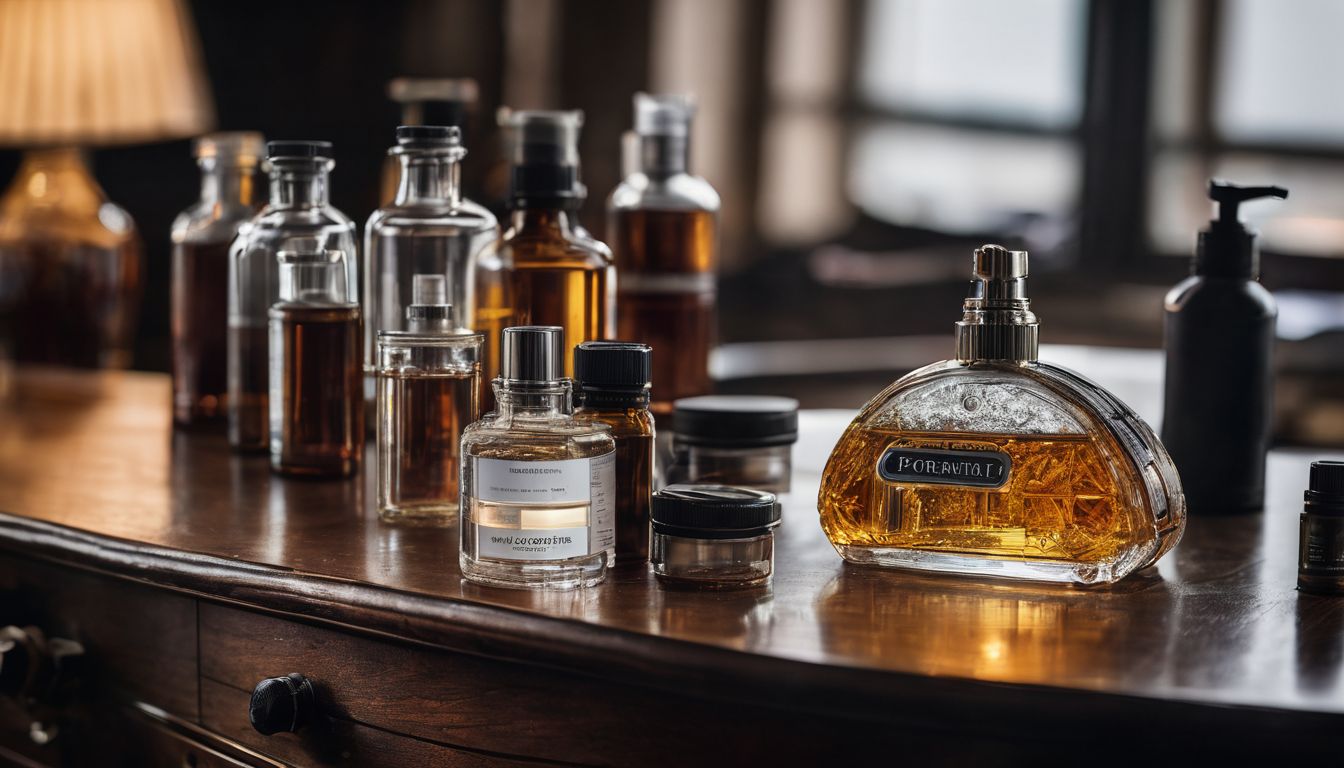The Science of Male Pheromones to Attract Females: What You Need to Know
Have you ever wondered why some men seem to attract women without even trying? It might be due to pheromones, natural chemicals that can play a big part in attraction. Our blog explores the fascinating science behind male pheromones and how they could be influencing your love life.
Dive in and uncover secrets that might transform the way you connect with females!
Key Takeaways
- Pheromones are natural chemicals that affect attraction; male scents like androstenone may boost a woman’s perception of a man’s attractiveness.
- Scientific research supports the idea that pheromones play a role in sexual attraction, although their exact impact on human behavior and mate selection is still being studied.
- There is debate over the effectiveness of pheromone products, with concerns about ethical implications and regulation within the industry.
- Exposure to male pheromones such as androstadienone has been linked to increased attractiveness ratings from females, influencing mood and potentially sexual responses.
- Ongoing studies continue to examine how different types of pheromones contribute to social interactions, including mating behaviors.
What are Pheromones and How Do They Work?
Pheromones are natural chemical signals that play a role in attraction and mating behavior. They are produced by the body and perceived through the olfactory system, influencing human behavior without conscious awareness.
Definition of pheromones
Pheromones are special chemical messengers that animals and plants emit to influence the behavior of others in their species. These natural body scents can trigger a wide range of responses, including sexual attraction.
They play a key role in mating behaviors, helping potential mates assess compatibility and readiness for reproduction. In humans, these olfactory signals may affect mood and even perceptions of attractiveness.
Scientists have isolated several types of pheromones, such as androstenone and copulins, which carry different messages. Research continues to uncover how these potent chemicals impact human interaction, especially in the context of masculinity enhancement and attracting women.
Moving on from their basic definition, we’ll delve into the specific role they play in drawing people together romantically or sexually.
The role of pheromones in attraction
Pheromones play a significant role in attraction, influencing potential mates’ mood and behavior. Androstadienone exposure in women has been shown to enhance the attractiveness ratings of potential mates, while the male pheromone androstenol, present in fresh sweat, is particularly appealing to females.
These airborne compounds can communicate sexual orientation and genetic makeup, potentially impacting mate selection and behavior.
The effect of pheromones on humans continues to be a subject of ongoing research. While their impact on animal mate attraction is well-documented, their precise mechanisms in human attraction are still unclear.
Studies suggest that human pheromone perfumes may have a similar effect to animal pheromones in attracting mates but further evidence is needed to affirm this effect. The presence and influence of pheromones in both males and females continue to be topics of interest for scientists exploring the complex dynamics of human attraction.
How they are produced and perceived
The production and perception of pheromones play a crucial role in mate attraction. These chemical signals are produced by animals, including humans, and can influence mood and behavior in potential mates.
Pheromones are perceived through the olfactory system — the sense of smell — where they can affect attractiveness ratings and sexual responses. Studies have shown that exposure to specific male pheromones like androstenone can attract females, while airborne compounds, including pheromones, can communicate traits such as mood and genetic makeup.
Although research on human pheromones is ongoing, it is clear that these chemical signals have the potential to impact mate attraction and relationships.
The Link Between Pheromones and Sexual Attraction
Scientific studies have shown that pheromones play a significant role in sexual attraction, affecting the brain and potentially influencing mating preferences and behavior. Understanding the connection between pheromones and attraction can shed light on how they impact human relationships.
Scientific studies supporting the role of pheromones in attraction
Scientific studies have shown that exposure to male pheromones can influence the attractiveness ratings of potential mates.
- Exposure to androstadienone in women has been found to enhance the perceived attractiveness of potential male partners.
- Studies indicate that male pheromones may trigger a boost in sexual responses among both men and women, although further evidence is required to confirm this effect.
- Human pheromone perfumes are believed to mimic the effects of animal pheromones, potentially enhancing attraction between individuals.
- Airborne compounds, including pheromones, can broadcast information about moods, sexual orientation, and genetic traits.
- Ongoing research aims to understand how human pheromones function in mate attraction and communication.
The effect of pheromones on the brain
Pheromones can influence brain activity, affecting mood and behavior. Androstadienone exposure in women has been linked to increased attractiveness ratings of potential mates, indicating a direct impact on the brain’s perception of desirability.
Some studies suggest that pheromones play a role in boosting sexual responses in both men and women, although further evidence is necessary to confirm this effect. While the specific mechanisms through which pheromones affect the brain are not fully understood, ongoing research aims to uncover how these natural scents influence human behavior and attraction.
Moving forward – The potential influence on mating preferences and behavior
The potential influence on mating preferences and behavior
Pheromones can impact mating preferences and behavior by influencing mood and attractiveness. Exposure to male pheromones like androstenone has been shown to affect potential mates’ ratings of attractiveness.
Additionally, androstadienone in women has been linked to enhanced sexual responses, potentially influencing their preferences for mates. Ongoing research into human pheromones continues to explore the extent of their influence on mating behaviors.
Moving forward, let’s delve into the different types of pheromones and their effects on attraction.
Different Types of Pheromones and Their Effects
Androstenone, Androsterone, Androstadienone, and Copulins are the different types of pheromones that can potentially attract females in various ways. Learn more about how these pheromones work and their effects on female attraction.
Androstenone
Androstenone is a male pheromone that exudes masculinity and dominance, known for its earthy scent. This compound has been studied for its potential to attract women due to its impact on their mood and sexuality.
Studies have shown that androstenone may influence female attraction, although ongoing research is delving into the specifics of how it affects potential mates’ attractiveness. Additionally, the effect of this pheromone on men’s responses and behavior towards potential partners is a topic under investigation.
The scent of androstenone in natural body essential oils or pheromone colognes for men can potentially play a role in attracting females by eliciting an immediate behavioral or communicative response, based on scientific studies.
Androsterone
Androsterone, a type of male pheromone, is a steroid compound that is naturally produced by men. It is known for its earthy, musky scent and is believed to exude masculinity and dominance.
Research suggests that androsterone may play a role in attracting women due to its potential impact on female attraction. This particular pheromone has been associated with drawing attention from potential mates, influencing their mood and sexuality.
One study found that exposure to male axillary secretions containing androsterone led to increased attractiveness ratings in females. While the exact mechanism of how androsterone influences human behavior is still under investigation, it holds promise as a natural element in the realm of attraction and relationships.
Androstadienone
Androstadienone, a male pheromone, has been found to influence the attractiveness ratings of potential mates in women. This compound is believed to affect women’s mood and sexual responses when exposed to it.
It is one of the key components that make up male pheromones aimed at attracting females. Scientific studies have shown that androstadienone can have an impact on female attraction towards males, indicating its potential role in human mate selection.
Research on the effect of androstadienone provides insight into how certain chemicals may play a role in influencing mating preferences and behavior. These findings contribute to ongoing inquiries about natural body scents’ effects on female attraction and the development of pheromone-infused fragrances for men aiming to attract potential mates.
Copulins
Copulins are a mix of fatty acids secreted by the female reproductive system. They play a crucial role in human social and sexual behavior. These compounds enhance male arousal, potentially impacting their testosterone levels and mood, therefore influencing their attractiveness to females.
The presence of copulins is believed to elevate men’s response to sexual stimuli by triggering an increase in testosterone production. This can lead to enhanced sexual interest and satisfaction, making copulins an essential component in the complex interplay of pheromones and attraction.
– The Role of Pheromones in Mating Behaviors
The Controversies Surrounding Pheromones and Attraction
Pheromone products have faced criticism regarding their effectiveness, ethical concerns, and regulation. The debate over the impact of pheromones on attraction continues to be a topic of controversy in the scientific community.
Criticisms of pheromone products
Some critics argue that pheromone products are marketed with exaggerated claims about their effectiveness in attracting mates. Ethical concerns have been raised regarding the lack of regulation and transparency in the pheromone product industry, as well as the potential exploitation of consumers‘ desires for romantic or sexual success.
Additionally, there is ongoing debate over the scientific evidence supporting the efficacy of pheromone-infused fragrances and oils, with some suggesting that the supposed effects may be more placebo than scientifically proven.
As research on human pheromones continues to evolve, it’s crucial to critically analyze and evaluate the claims surrounding these products to ensure consumers are making informed choices.
Ethical concerns and regulation
Pheromones have sparked ethical concerns and regulatory debate due to the potential influence they may have on human behavior. The use of pheromone-infused fragrances and products raises questions about informed consent and the manipulation of natural attraction cues.
Additionally, there are challenges in regulating these products as their effectiveness is still under scrutiny, impacting consumer trust. Ensuring transparency in advertising claims and conducting further research to validate the impact of pheromones on attraction will be crucial for addressing these ethical concerns and establishing clear regulations in this emerging market.
As scientists continue to investigate the complexities surrounding pheromones and attraction, it is essential to explore both sides — skepticism about their efficacy and enthusiasm for their potential benefits.
Ongoing dialogue among experts, regulators, consumers, and manufacturers will be crucial for shaping guidelines around transparency, safety standards, marketing practices, and product efficacy as this field continues to evolve.
The debate over the effectiveness of pheromones
There remains ongoing debate over the effectiveness of pheromones in attracting potential mates. While some studies suggest that pheromone-infused fragrances can influence mood and behavior, more evidence is needed to confirm their impact on attraction.
Critics raise concerns about the ethical implications of using pheromone products and question their regulation. Despite the controversies, research into human pheromones continues, with scientists striving to unravel the complexities of how these chemical signals may affect mating preferences and behaviors.
Some researchers argue that while pheromones have been shown to cause an instant behavioral response in animal mate attraction, it is still unclear how they work in humans. This uncertainty has led to skepticism regarding the effectiveness of commercialized pheromone perfumes for both men and women, adding fuel to the contentious discussion surrounding this area of study.
Conclusion: The Role of Pheromones in Attraction
Pheromones play a significant role in attraction and mating preferences, with ongoing research and development exploring their potential impact on relationships. To learn more about the science of male pheromones to attract females, continue reading our blog!
The potential impact of pheromones on attraction and relationships
Male pheromones, like androstenone and androstenol, can influence a woman’s perception of masculinity and attractiveness. Exposure to these pheromones may trigger positive mood changes in women, potentially leading to increased sexual interest.
Studies have shown that airborne compounds such as pheromones can communicate genetic information and affect mate attraction. While the true extent of their impact on human relationships is still under investigation, it’s clear that these natural scents play a role in influencing initial attraction between potential mates.
The presence of pheromone-infused fragrances suggests an interest in harnessing the power of these scents to attract potential partners. While debates around their effectiveness continue, ongoing research into the link between male pheromones and female attraction underscores the importance placed on understanding how scent can impact human behavior and social interactions.
Future research and development of pheromone products
Researchers are actively exploring the potential of pheromone-infused fragrances to better understand their impact on human attraction. Studies aim to delve into the specific scents and chemical compounds that may enhance male attractiveness to females, while also investigating ethical concerns and regulatory guidelines.
Ongoing research seeks to uncover the effectiveness of natural body scents in attracting potential mates, shedding light on how these organic pheromone-infused fragrances could influence mating preferences and behavior.
With continuous advancements in technology and scientific methods, future studies will focus on unraveling the complexities of pheromones’ effect on mood, sexuality, and genetic makeup.
FAQs
1. What are male pheromones, and how do they attract females?
Male pheromones are natural body scents that can boost a man’s attractiveness to potential mates by signaling masculinity and dominance.
2. Can using pheromone-infused fragrances really make men more appealing to women?
Yes, men’s pheromones infused in fragrances blend sensual scents with earthy tones that may draw women’s attention and increase attraction.
3. What is Androstenol, and why is it important in attracting women?
Androstenol is a chemical found in male pheromones known for its effect on increasing a female’s mood towards sexuality and enhancing her perception of a man’s attractiveness.
4. How do pheromones affect a woman’s mood or feelings of attraction?
Pheromones can impact the way women feel by influencing their mood and sexuality, which plays a role in female attraction towards men.
5. Are there any organic options for men who want to use pheromone-infused products?
Organic pheromone-infused fragrances offer natural scent options for those seeking an eco-friendly choice without compromising the allure of attracting women.









